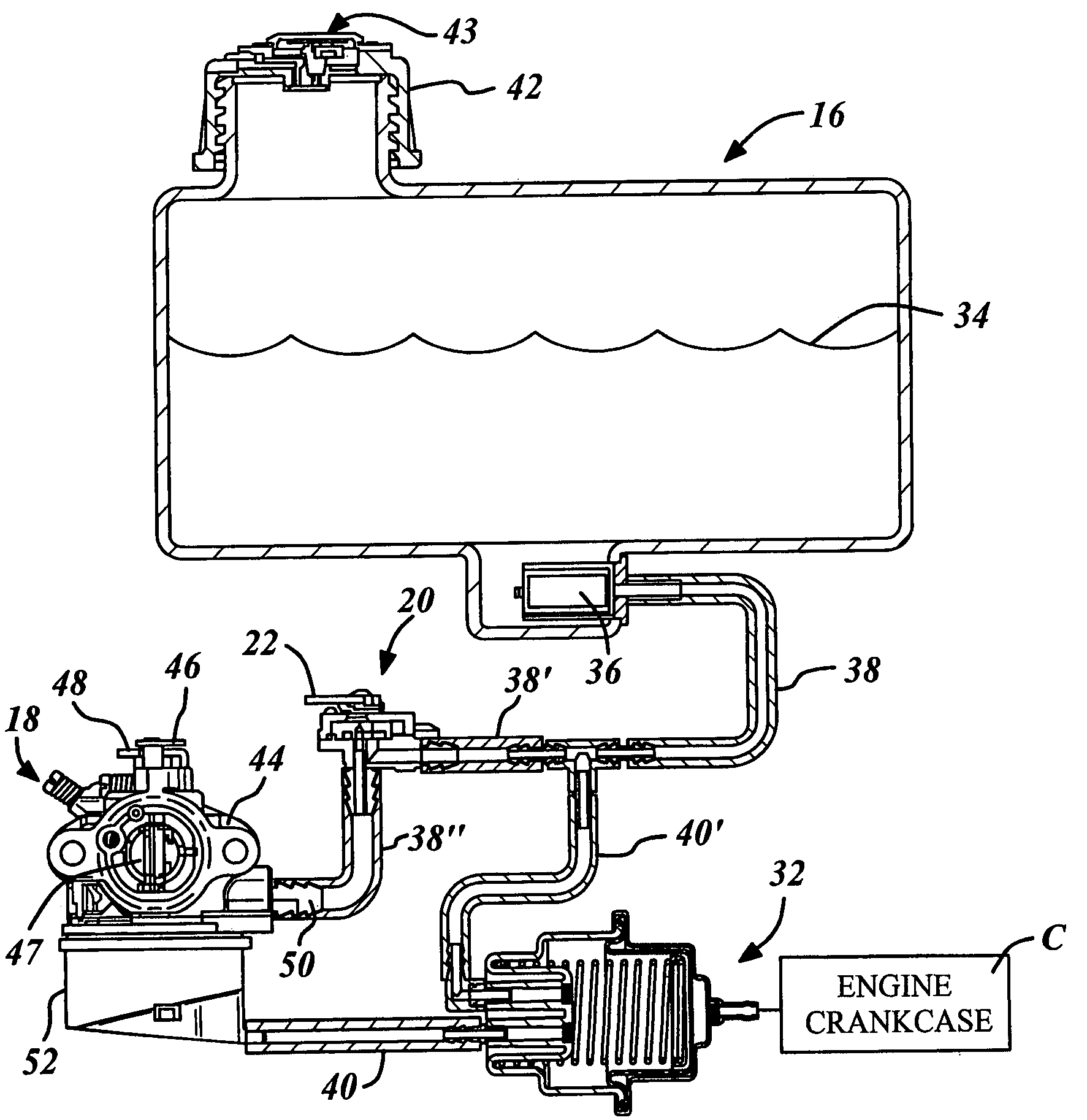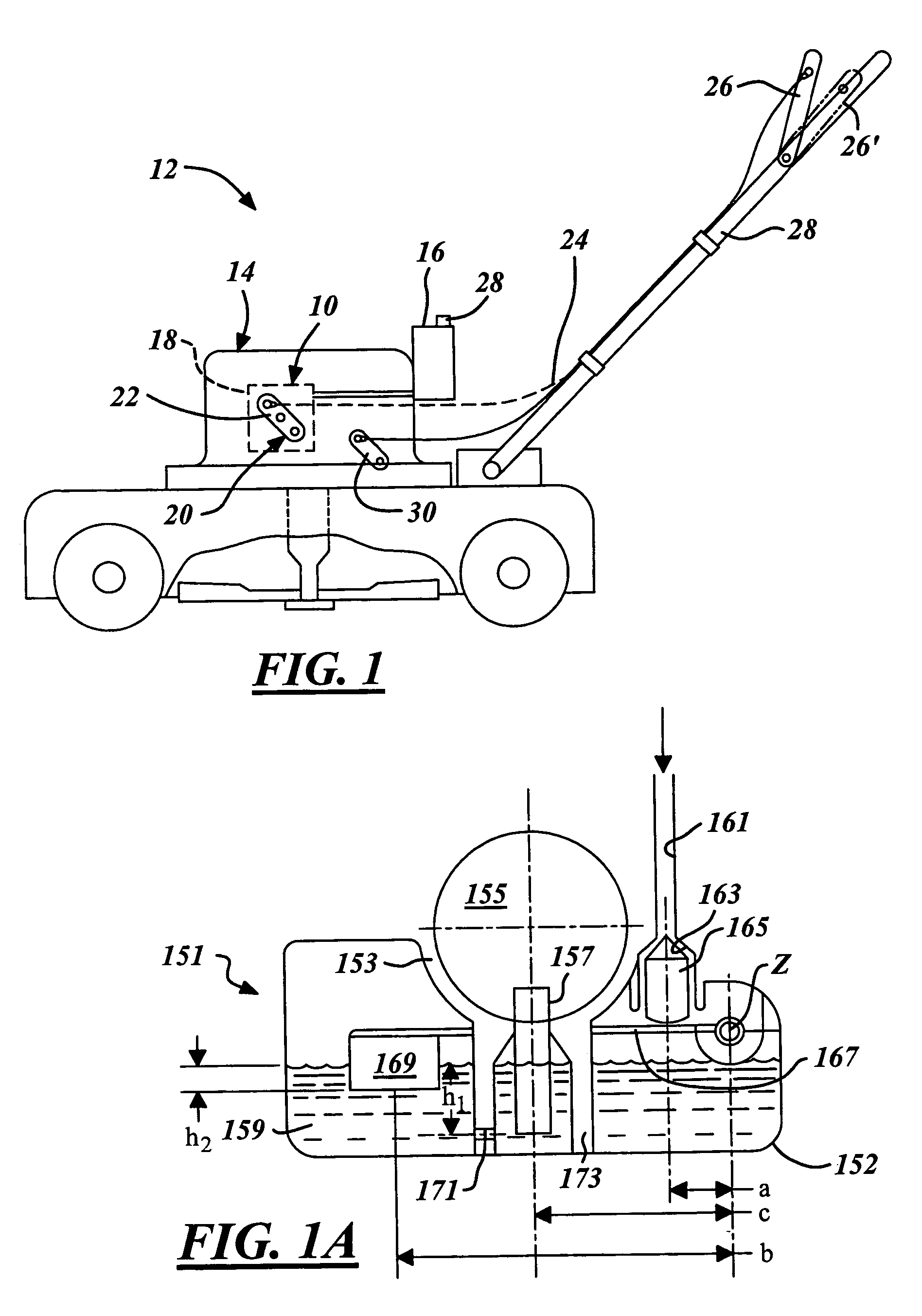Controlling evaporative emissions in a fuel system
a fuel system and evaporative emission technology, applied in the direction of fuel injection apparatus, charge feed system, non-fuel substance addition to fuel, etc., can solve the problems of evaporative loss, evaporation of liquid fuel into, evaporative loss the most, etc., to reduce or prevent evaporative emissions from the fuel system
- Summary
- Abstract
- Description
- Claims
- Application Information
AI Technical Summary
Benefits of technology
Problems solved by technology
Method used
Image
Examples
first exemplary embodiment
of a Mechanical Pump
[0088]The fuel is removed from the carburetor fuel chamber or bowl 52 preferably using a fuel transfer and storage unit, such as the mechanical accumulator or pump 32 of FIG. 2. It is contemplated that any suitable type of pump could be used including an electrically-actuated pump (“electric pump”), pneumatic mechanical pumps, plunger style mechanical pumps, and the like. As also shown in FIGS. 5 and 6, the pump 32 includes a housing 74 and a cover 76 attached to the housing 74, such as by a circumferential crimp joint as shown, to define an interior 78. The housing 74 and cover 76 are preferably stamped or machined from metal, molded from a polymeric material, or the like.
[0089]A diaphragm 80 is disposed within the interior 78 and is sealingly engaged between the cover 76 and housing 74 by the crimp joint to divide the interior 78 into a fuel reservoir 82 on a reservoir side of the diaphragm 80 for carburetor bowl drainage, and an actuation chamber 84 on an actu...
second exemplary embodiment
of a Fuel System
[0126]FIGS. 27 through 30 illustrate in block diagram, another exemplary embodiment of a fuel system that generally depicts many of the features of the previous embodiments and that includes some additional features. This embodiment is similar in many respects to the previously described embodiments and like numerals between the embodiments generally designate like or corresponding elements throughout the several views of the drawing figures. Accordingly, some common subject matter may not be repeated in detail herein below.
[0127]The block diagrams of FIGS. 27 through 30 generally include an engine-powered apparatus or equipment 1012 having a combustion engine 1014 for powering the equipment 1012 and a fuel system for storing and distributing fuel to the engine 1014. The fuel system includes a fuel tank 1016 for storing fuel, fuel lines or fluid paths for carrying fuel, a carburetor 1018 for mixing air with the fuel, and a combined fuel pump and valve actuation devic...
third exemplary embodiment
of a Fuel System
[0139]FIG. 31 schematically illustrates another exemplary embodiment of a fuel system that generally depicts many of the features of the previous embodiments and that includes some additional features. This embodiment is similar in many respects to the previously described embodiments and like numerals between the embodiments generally designate like or corresponding elements throughout the several views of the drawing figures. Accordingly, some common subject matter may not be repeated in detail herein below.
[0140]Referring now to FIG. 31, a gravity draining fuel system includes a fuel tank 1216, a carburetor 1218 generally elevated with respect to the fuel tank 1216, a pneumatically-actuated pump 1231 positioned generally beneath the fuel tank 1216 in fluid communication between the carburetor 1218 and the fuel tank 1216, and a four-way fitting 1233 positioned generally beneath the fuel tank 1216 in fluid communication between the fuel tank 1216 and carburetor 1218...
PUM
 Login to View More
Login to View More Abstract
Description
Claims
Application Information
 Login to View More
Login to View More - R&D
- Intellectual Property
- Life Sciences
- Materials
- Tech Scout
- Unparalleled Data Quality
- Higher Quality Content
- 60% Fewer Hallucinations
Browse by: Latest US Patents, China's latest patents, Technical Efficacy Thesaurus, Application Domain, Technology Topic, Popular Technical Reports.
© 2025 PatSnap. All rights reserved.Legal|Privacy policy|Modern Slavery Act Transparency Statement|Sitemap|About US| Contact US: help@patsnap.com



